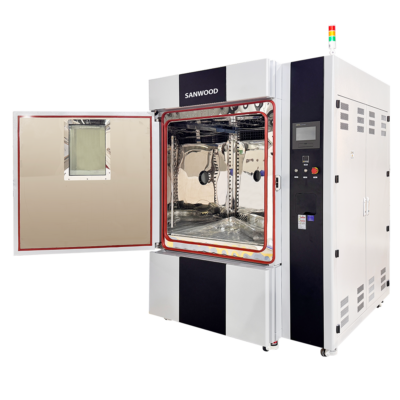Model of the equipment we have in our lab, Xenon lamp test chamber SMC-XD-1000-CB Sanwoood
What is Solar Radiation?
Solar radiation is the energy emitted by the Sun, transmitted through space, and received by the Earth. This energy is essential for life on Earth and plays a critical role in weather patterns, climate systems, and renewable energy generation.
Solar radiation includes a broad range of electromagnetic waves, primarily:
- Ultraviolet (UV) radiation
- Visible light
- Infrared (IR) radiation
When this energy reaches the Earth’s atmosphere, it is partly absorbed, reflected, and scattered, with the remaining portion reaching the Earth’s surface. The amount and intensity of solar radiation at any given location depend on several factors, including:
- Geographic location (latitude)
- Time of day and year (solar angle)
- Atmospheric conditions (clouds, dust, pollution)
- Surface orientation and tilt
Why Solar Radiation Matters
In scientific and industrial applications, measuring solar radiation is crucial for:
- Solar energy system design and optimization (e.g., photovoltaic panels)
- Climate and environmental research
- Agricultural planning
- Thermal testing and material degradation analysis
Our lab provides accurate and high-resolution solar radiation measurements to support these applications. We use calibrated sensors and real-time monitoring to ensure reliable data for research, development, and operational needs.
Here is the list of standards
- ISO 11341(Paints and varnishes-Artificial weathering and exposure to artificial radiation–Exposure to filtered xenon-arc radiation)
- ASTM G151(Standard Practice for Exposing Nonmetallic Materials in Accelerated)
- Test Devices that Use Laboratory Light Sources
- GB/T 1865 (Color paints and varnishes Artificial weathering and artificial radiation exposure Filtered xenon arc radiation)
- ASTM D6695, G151, G155
- ISO105-B02 105-B04, 105-B06, 11341, 3917, 4892-1, 4892-2, 12040.
- GB/2423.1-2008 (IEC60068-2-1:2007) low temperature test method AB.
- GB/T5170.5-2008 damp heat test equipment.
- GJBl50.4 (MIL-STD-810D) low temperature test method.
- GB2423.3-93 (IEC68-2-3) Test Ca: Constant damp heat test method.
- GB2423.4-93 (IEC68-2-30) Test Db: Alternating Damp Heat Test Method
1. ISO 11341 – Paints and Varnishes – Artificial Weathering Using Filtered Xenon Arc Radiation
Purpose: To evaluate the resistance of paints and varnishes to prolonged sunlight exposure, including UV radiation, using simulated filtered xenon arc light.
Practical Use: Testing color stability and surface durability in automotive, aerospace, construction, and coating industries.
2. ASTM G151 – Standard Practice for Accelerated Exposure of Nonmetallic Materials
Purpose: Provides guidelines for performing accelerated weathering tests on plastics, rubber, and coatings using various light sources (e.g., xenon, fluorescent).
Practical Use: Determining service life of non-metal materials and ensuring long-term durability.
3. Test Devices that Use Laboratory Light Sources
Purpose: Simulate environmental lighting conditions (UV, visible light, IR) under controlled laboratory conditions for material testing.
Practical Use: Accelerated aging tests for components and products under consistent and repeatable conditions.
4. GB/T 1865 – Paints and Varnishes – Artificial Weathering Using Filtered Xenon Arc Light (Chinese Standard)
Purpose: Equivalent to ISO 11341; tests the resistance of color coatings to artificial radiation exposure.
Practical Use: Used in paint, plastic, and automotive industries to assess color fading, cracking, and surface degradation.
5. ASTM D6695, G151, G155 – Accelerated Weathering Standards
Purpose: G155 covers xenon arc devices; D6695 provides test methods for coatings under artificial light.
Practical Use: Simulating solar damage on coatings and polymers, mainly for outdoor applications.
6. ISO 105-B02, B04, B06, 11341, 3917, 4892-1, 4892-2, 12040 – Lightfastness and Radiation Resistance Standards
Purpose: Test lightfastness, aging, and radiation resistance of textiles, plastics, and coatings.
Practical Use: Used in apparel, automotive, construction, and outdoor product testing. For example, B02 tests color fading of fabrics under sunlight.
7. GB/2423.1-2008 (IEC 60068-2-1:2007) – Low Temperature Test Method (Method AB)
Purpose: Assess performance and resistance of components under extreme low temperatures.
Practical Use: Used for electronic, military, and aerospace equipment exposed to arctic or high-altitude environments.
8. GB/T 5170.5-2008 – Damp Heat Test Equipment Standard
Purpose: Specifies performance requirements for humidity and heat test chambers.
Practical Use: Ensures reliability of environmental test equipment used in quality and compliance testing.
9. GJBl50.4 (MIL-STD-810D) – Low Temperature Test (Military Standard)
Purpose: Evaluates performance of equipment under harsh military environmental conditions, including extreme cold.
Practical Use: Used for military systems, aviation electronics, and field gear under combat or field conditions.
10. GB 2423.3-93 (IEC 68-2-3) – Constant Damp Heat Test (Test Ca)
Purpose: Tests long-term exposure to constant high humidity.
Practical Use: Ensures long-term performance of electronics in tropical or humid environments.
11. GB 2423.4-93 (IEC 68-2-30) – Cyclic Damp Heat Test (Test Db)
Purpose: Simulates alternating humidity cycles (e.g., day/night) to evaluate moisture impact.
Practical Use: Relevant for outdoor systems like HVAC units, power stations, and control panels in humid climates.



